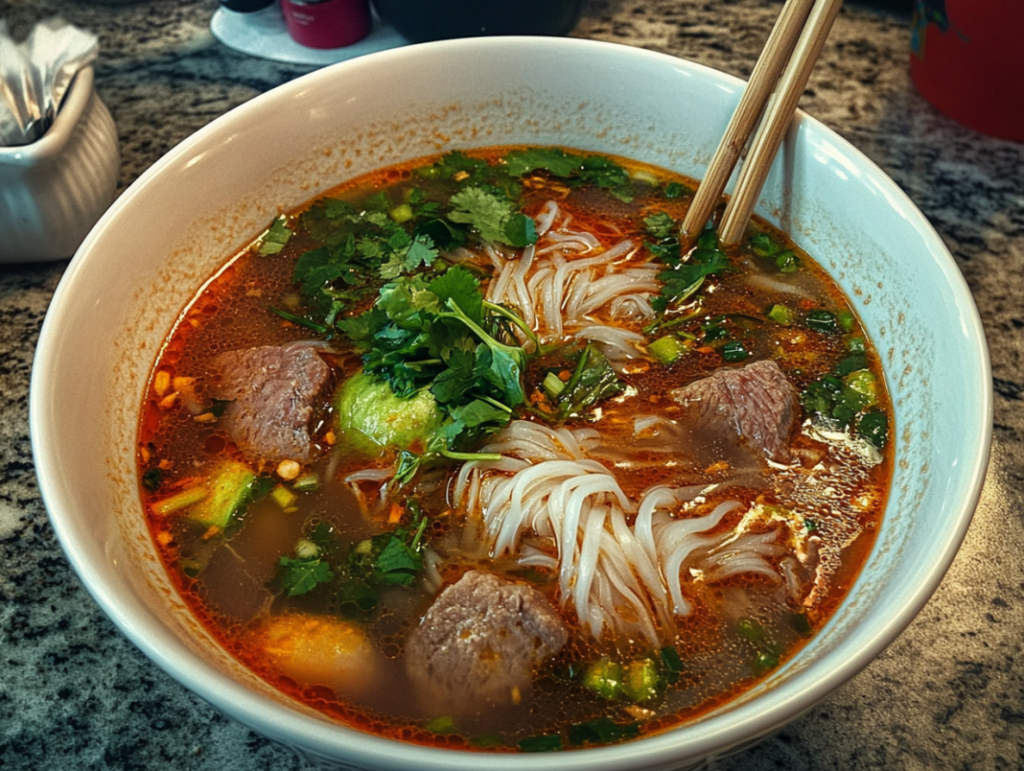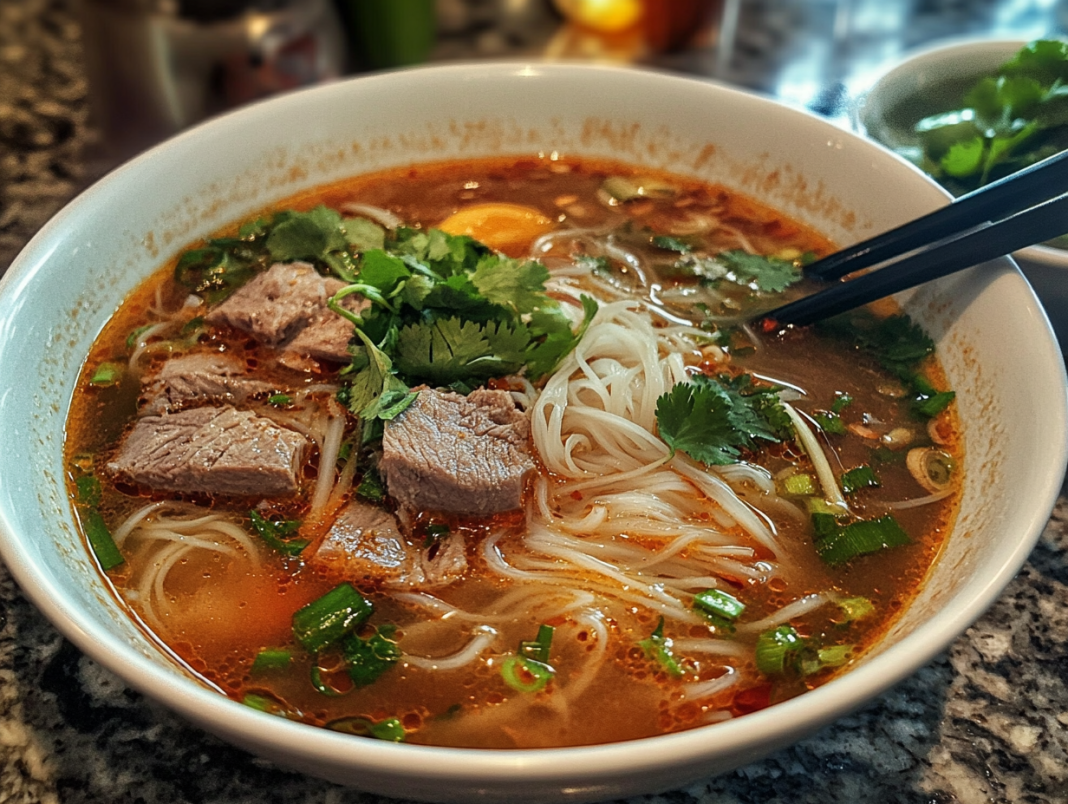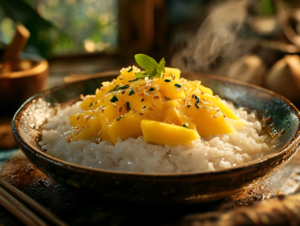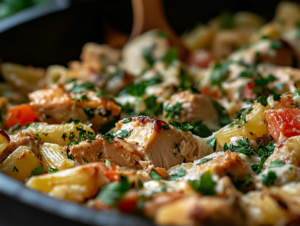Beef pho soup, known as phở bò in Vietnamese, is a beloved dish that has captured the hearts and palates of food enthusiasts worldwide. This aromatic noodle soup, characterized by its rich broth, tender slices of beef, and fresh herbs, offers a harmonious blend of flavors and textures that epitomize Vietnamese cuisine. In this comprehensive guide, we’ll delve into the intricacies of crafting an authentic bowl of beef pho, ensuring you can recreate this culinary masterpiece in your own kitchen.
The Essence of Beef Pho
Originating from Northern Vietnam, pho has evolved into various regional styles, each with its unique nuances. The Southern variation, Phở Saigon, is particularly renowned for its sweeter broth and an abundance of fresh herbs and condiments. Central to all versions, however, is the meticulous preparation of the broth—a process that transforms simple ingredients into a deeply flavorful and aromatic foundation.
The Significance of Beef Pho in Vietnamese Culture
Pho holds a special place in Vietnamese culture, symbolizing warmth, comfort, and communal dining. It’s a dish that brings families together and is often shared during special occasions and gatherings. The meticulous preparation of Pho reflects the Vietnamese appreciation for balance and harmony in flavors.
Essential Ingredients for Authentic Beef Pho
To embark on your Pho-making journey, gather the following ingredients:
For the Broth:
-
Beef Bones: A combination of marrow and knuckle bones to create a rich, gelatinous base.
-
Beef Brisket or Chuck: Adds depth and meaty richness to the broth.
-
Onions and Ginger: Charred to impart a smoky sweetness.
-
Spices: Star anise, cinnamon sticks, cloves, coriander seeds, and cardamom pods.
-
Fish Sauce: Provides umami and saltiness.
-
Sugar: Balances the flavors with a hint of sweetness.
-
Salt: Enhances the overall taste.
For the Soup Assembly:
-
Rice Noodles: Flat, medium-sized, traditionally used in Pho.
-
Beef Sirloin or Eye of Round: Thinly sliced; cooks quickly when added to the hot broth.
Garnishes:
-
Fresh Herbs: Thai basil, cilantro, and mint.
-
Bean Sprouts: Adds crunch and freshness.
-
Lime Wedges: For a zesty kick.
-
Chili Peppers: Sliced, for those who prefer heat.
-
Hoisin and Sriracha Sauces: Optional condiments for added flavor.
Step-by-Step Directions to Prepare Beef Pho
Preparing the Broth:
-
Blanch the Bones: Place beef bones in a large pot, cover with water, and bring to a boil. Simmer for 10 minutes to remove impurities. Drain and rinse the bones thoroughly.
-
Char the Aromatics: While the bones are blanching, char the onions and ginger over an open flame or in a dry skillet until blackened. This step enhances the broth’s depth of flavor.
-
Toast the Spices: In a dry pan, toast the star anise, cinnamon sticks, cloves, coriander seeds, and cardamom pods until fragrant.
-
Simmer the Broth: In a clean large pot, combine the blanched bones, charred aromatics, and toasted spices. Fill with water to cover the ingredients. Bring to a boil, then reduce to a gentle simmer. Skim any foam that rises to the surface.
-
Add Beef and Seasonings: Add the beef brisket or chuck to the pot. Season with fish sauce, sugar, and salt. Continue to simmer for 3-4 hours, allowing the flavors to meld and the meat to tenderize.
-
Strain the Broth: Remove the bones, meat, and aromatics. Strain the broth through a fine-mesh sieve or cheesecloth to achieve a clear, flavorful liquid.
Preparing the Noodles and Beef:
-
Cook the Noodles: Soak the rice noodles in warm water for about 30 minutes until pliable. Then, cook them briefly in boiling water for 30-60 seconds until tender but firm. Drain and set aside.
-
Slice the Beef: While the broth is simmering, place the beef sirloin or eye of round in the freezer for about 15-20 minutes to firm up. This makes it easier to slice thinly. Once firm, slice the beef against the grain into paper-thin slices.
Assembling the Pho Bowls:
-
Prepare the Bowls: Divide the cooked noodles among serving bowls.
-
Add the Beef: Arrange the thinly sliced raw beef atop the noodles.
-
Ladle the Broth: Bring the strained broth back to a rolling boil. Carefully ladle the hot broth over the beef and noodles. The heat of the broth will cook the raw beef slices.
-
Garnish: Serve with fresh herbs, bean sprouts, lime wedges, and chili peppers on the side, allowing each diner to customize their bowl to taste.
Nutritional Information
A typical serving of Beef Pho provides a balanced mix of protein, carbohydrates, and fats. Here’s an approximate breakdown per serving:
-
Calories: 450 kcal
-
Protein: 35g
-
Carbohydrates: 60g
-
Fat: 10g
-
Fiber: 2g
-
Sodium: 900mg
Note: Nutritional values may vary based on specific ingredients and portion sizes.
Serving Size and Preparation Times
This homemade Beef Pho recipe yields approximately 6 servings, making it perfect for a family meal or a small gathering. The process requires patience and attention to detail, but the final result is well worth the effort. Preparation time is about 30 minutes, which includes chopping and prepping ingredients. The cooking time is approximately 4-5 hours, as the broth needs to simmer slowly to extract deep, rich flavors. While this might seem like a long time, much of it is hands-off, allowing the flavors to develop naturally. If you prefer to make it ahead of time, the broth can be prepared a day in advance and refrigerated, allowing the fat to solidify at the top, making it easier to skim before reheating.
Tips for the Best Homemade Beef Pho
Making the perfect bowl of Pho requires technique and attention to detail. One of the most crucial steps is blanching the beef bones before making the broth. This removes impurities, ensuring a clear and clean-tasting broth. Charring the onions and ginger is another step that should not be skipped, as it adds a smoky, slightly caramelized depth that enhances the overall flavor. To achieve a well-balanced broth, it’s essential to simmer the bones gently—boiling too vigorously will result in a cloudy broth. The use of fish sauce and rock sugar helps to balance the umami and sweetness, creating that signature Pho taste.
The type of beef you choose also plays a significant role. For tender slices of beef in your soup, make sure to freeze the meat slightly before slicing. This allows for ultra-thin cuts that cook instantly in the hot broth. If you prefer a more traditional approach, add tendon or beef meatballs for extra texture and flavor. As for the noodles, avoid overcooking them. Rice noodles cook quickly, so a brief soak in hot water right before serving ensures they maintain their slightly chewy texture.
How to Store and Reheat Beef Pho
Pho is best enjoyed fresh, but if you have leftovers, proper storage is key. The broth should be stored separately from the noodles and toppings to prevent sogginess. Once cooled, transfer the broth to an airtight container and refrigerate for up to 4 days. It also freezes well for up to 3 months—just make sure to leave some space in the container for expansion. When ready to serve, bring the broth to a rolling boil before assembling the bowls. If the broth has been refrigerated, you may need to skim off the solidified fat before reheating.
Noodles, on the other hand, should be stored separately in the fridge, lightly coated in a bit of oil to prevent sticking. When reheating, simply dunk them in boiling water for 10-15 seconds before serving. The fresh herbs and garnishes should always be added right before serving to retain their crispness and flavor.
Variations of Beef Pho
Beef Pho is incredibly versatile, allowing for many delicious variations. While Pho Bò Tái (Pho with raw beef slices) is the most popular version, you can also try Pho Bò Chin (Pho with well-done brisket), Pho Bò Gân (Pho with beef tendon), or Pho Bò Viên (Pho with beef meatballs). Each variation offers a slightly different texture and experience while maintaining the same deeply flavorful broth.
For a low-carb option, you can replace the rice noodles with zucchini noodles or shirataki noodles. Another modern twist is to use bone broth instead of traditional simmered beef bones for an even richer nutritional profile. If you prefer a spicier broth, consider adding crushed chili flakes or a dash of Sriracha directly into the broth as it simmers.
Vegetarians can also enjoy a similar dish by making Vegetarian Pho, replacing the beef bones with a rich vegetable broth made from mushrooms, carrots, and daikon radish. Instead of beef, tofu or plant-based protein can be used, and the result is just as comforting and delicious.
What to Serve with Beef Pho
A well-crafted bowl of Beef Pho is already a complete meal, but it can be paired with Vietnamese side dishes to enhance the dining experience. A popular accompaniment is Vietnamese spring rolls (Gỏi Cuốn), which are fresh, light, and dipped in a savory peanut or hoisin sauce. If you prefer something crispy, fried spring rolls (Chả Giò) offer a crunchy contrast to the soup.
For drinks, Vietnamese iced coffee (Cà Phê Sữa Đá) provides a sweet and bold counterpoint to the savory broth, while jasmine or green tea complements the meal with its subtle floral notes. If you want to go all out, serve Pho with a side of Bánh Mì, a Vietnamese sandwich filled with pickled vegetables and meats, creating a fusion of flavors in one meal.
Why You Should Make Beef Pho at Home
While restaurant-quality Pho is widely available, making it at home allows for full control over the ingredients and flavors. You can adjust the saltiness, sweetness, and spice levels to match your personal preferences. Additionally, homemade Pho is more cost-effective, especially if you’re cooking for multiple people. By making a large batch of broth, you can enjoy multiple servings over several days.
Another significant advantage of homemade Pho is health benefits. Many store-bought or restaurant versions contain added MSG, excessive sodium, or preservatives. By preparing it yourself, you can use natural, wholesome ingredients and reduce unnecessary additives. Furthermore, the collagen and minerals from the simmered bones contribute to joint health, digestion, and overall well-being.
Final Thoughts
Beef Pho Soup is more than just a meal—it’s an experience that brings warmth, comfort, and a deep appreciation for Vietnamese culinary tradition. With its aromatic broth, tender beef, and fresh herbs, this dish is a true labor of love that rewards you with complex layers of flavor in every bite. Whether you’re making it for yourself, family, or friends, the effort you put into crafting this dish will be evident in every sip and slurp.
Now that you have everything you need to make authentic Beef Pho Soup, why not give it a try? Gather your ingredients, set aside a few hours, and enjoy the rewarding process of creating one of the world’s most cherished noodle soups. Let us know in the comments how your homemade Pho turned out, and feel free to share any personal twists or variations!
Print
The Ultimate Guide to Crafting Authentic Beef Pho Soup at Home
Ingredients
To embark on your Pho-making journey, gather the following ingredients:
For the Broth:
-
Beef Bones: A combination of marrow and knuckle bones to create a rich, gelatinous base.
-
Beef Brisket or Chuck: Adds depth and meaty richness to the broth.
-
Onions and Ginger: Charred to impart a smoky sweetness.
-
Spices: Star anise, cinnamon sticks, cloves, coriander seeds, and cardamom pods.
-
Fish Sauce: Provides umami and saltiness.
-
Sugar: Balances the flavors with a hint of sweetness.
-
Salt: Enhances the overall taste.
For the Soup Assembly:
-
Rice Noodles: Flat, medium-sized, traditionally used in Pho.
-
Beef Sirloin or Eye of Round: Thinly sliced; cooks quickly when added to the hot broth.
Garnishes:
-
Fresh Herbs: Thai basil, cilantro, and mint.
-
Bean Sprouts: Adds crunch and freshness.
-
Lime Wedges: For a zesty kick.
-
Chili Peppers: Sliced, for those who prefer heat.
-
Hoisin and Sriracha Sauces: Optional condiments for added flavor.
Instructions
Preparing the Broth:
-
Blanch the Bones: Place beef bones in a large pot, cover with water, and bring to a boil. Simmer for 10 minutes to remove impurities. Drain and rinse the bones thoroughly.
-
Char the Aromatics: While the bones are blanching, char the onions and ginger over an open flame or in a dry skillet until blackened. This step enhances the broth’s depth of flavor.
-
Toast the Spices: In a dry pan, toast the star anise, cinnamon sticks, cloves, coriander seeds, and cardamom pods until fragrant.
-
Simmer the Broth: In a clean large pot, combine the blanched bones, charred aromatics, and toasted spices. Fill with water to cover the ingredients. Bring to a boil, then reduce to a gentle simmer. Skim any foam that rises to the surface.
-
Add Beef and Seasonings: Add the beef brisket or chuck to the pot. Season with fish sauce, sugar, and salt. Continue to simmer for 3-4 hours, allowing the flavors to meld and the meat to tenderize.
-
Strain the Broth: Remove the bones, meat, and aromatics. Strain the broth through a fine-mesh sieve or cheesecloth to achieve a clear, flavorful liquid.
Preparing the Noodles and Beef:
-
Cook the Noodles: Soak the rice noodles in warm water for about 30 minutes until pliable. Then, cook them briefly in boiling water for 30-60 seconds until tender but firm. Drain and set aside.
-
Slice the Beef: While the broth is simmering, place the beef sirloin or eye of round in the freezer for about 15-20 minutes to firm up. This makes it easier to slice thinly. Once firm, slice the beef against the grain into paper-thin slices.
Assembling the Pho Bowls:
-
Prepare the Bowls: Divide the cooked noodles among serving bowls.
-
Add the Beef: Arrange the thinly sliced raw beef atop the noodles.
-
Ladle the Broth: Bring the strained broth back to a rolling boil. Carefully ladle the hot broth over the beef and noodles. The heat of the broth will cook the raw beef slices.
-
Garnish: Serve with fresh herbs, bean sprouts, lime wedges, and chili peppers on the side, allowing each diner to customize their bowl to taste.





